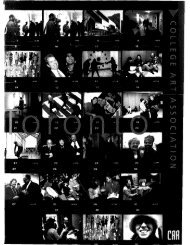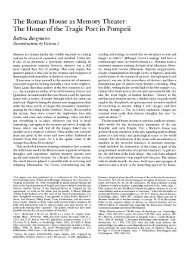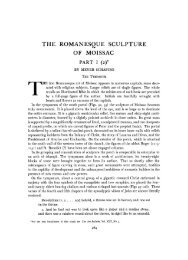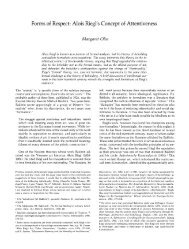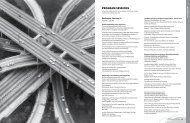THE HUMANISTIC THEORY OF PAINTING - College Art Association
THE HUMANISTIC THEORY OF PAINTING - College Art Association
THE HUMANISTIC THEORY OF PAINTING - College Art Association
Create successful ePaper yourself
Turn your PDF publications into a flip-book with our unique Google optimized e-Paper software.
UT PICTURA POESIS: <strong>HUMANISTIC</strong> <strong>THE</strong>ORY <strong>OF</strong> <strong>PAINTING</strong> 205<br />
may improve upon nature; in all other respects he is hopelessly outclassed. The old notion<br />
of exact imitation Dolce can still accept with some enthusiasm for nature in general, but for<br />
the all-important human figure to which in Italian painting the rest of nature had always<br />
been subsidiary, it will no longer do. And it is apropos of the human figure in action that<br />
Dolce, following the method of literary critics of his day who were prescribing rules for<br />
poetry based on Aristotle and Horace,41 developed his own doctrine of ideal imitation. It<br />
will be worth while briefly to examine his treatment of the doctrine, for it contains, though<br />
in attenuated and undeveloped form, most of the fundamentals of an aesthetic theory that<br />
will persist for two centuries.<br />
Dolce discusses two ways whereby the painter may, to repeat Aristotle's phrase,<br />
represent life not as it is, but as it ought to be. By a method which Aristotle would have<br />
approved, he may go direct to nature, and selecting the fairest parts from a number of in-<br />
dividuals, produce a composite figure more perfect than commonly exists. This was the<br />
celebrated method of Zeuxis in painting the divine beauty of Helen, and one that few writers<br />
on painting after Alberti ever forgot to extol.42 Or he may use as perfect a single model as<br />
he can find, following the example of Apelles and Praxiteles who rendered their celebrated<br />
images of Aphrodite after Phryne, most beautiful of courtesans. Now in the golden age of<br />
antiquity an Apelles who had a Phryne for a model could succeed by this really unorthodox<br />
method. But a modern artist, Dolce insists, cannot find a standard of perfection in a single<br />
woman, for nature even under the best conditions is never without her defects. If then<br />
the artist, correcting her imperfections, would "surpass nature," would render her fairer<br />
than she is, he must be guided by a study of the faultless antique. For the antique is already<br />
that ideal nature for which the painter strives and "the ancient statues contain all the<br />
perfection of art."43<br />
41. The most important sixteenth-century treatises on<br />
poetry were the following: Vida, De arte poetica, Rome,<br />
1527 (in verse); Daniello, La poetica, Venice, 1536; Robor-<br />
telli, In librum Aristotelis de arte poetica explicationes,<br />
Florence, 1548; Fracastoro, Naugerius sive de poetica dia-<br />
logus, Venice, 1555; Minturno, De poeta, Venice, 1559, and<br />
L'arte poetica, Venice, 1564; J. C. Scaliger, Poetices, Geneva,<br />
I561; Castelvetro, La poetica d'Aristotele, vulgarizzata et<br />
sposta, Vienna, I570; Torquato Tasso, Discorsi dell'arte<br />
poetica, Venice, 1587. All of the comparisons between paint-<br />
ing and poetry in Aristotle and Horace were also available<br />
to the critics of painting in these influential treatises where<br />
they recur many times. The following, for instance, is<br />
Minturno's way of summing up Aristotle's position that<br />
poetry and painting have the same objects of imitation,<br />
but that their means of imitation are different: "Ne pi i la<br />
poesia, che la pittura questa varieth di persone ci discrive<br />
[Minturno has just been saying that poets represent men<br />
as better or worse than they are, or as average]. Percioche<br />
tra pittori Polygnoto i migliori dipinse; Pausone i peggiori;<br />
Dionysio i mezzani. Diverse anchora sono le cose con le<br />
quali si fa l'imitazione. Conciosia cosa che i pittori con li<br />
colori e co' liniamenti la facciano: ... i poeti, com' ho<br />
detto, con le parole, con l'harmonia, con li tempi" (L'arte<br />
poetica, pp. 2-3). Cf. notes 12, 13, 26, 27.<br />
42. See note 40.<br />
43. Op. cit., p. 19o: "Devesi adunque elegger la forma<br />
pihi perfetta, imitando parte la Natura. II che faceva Apelle,<br />
il quale ritrasse la sua tanto celebrata Venere, che usciva<br />
dal Mare... da Frine famosissima cortigiana della sua<br />
eta; et ancora Prasitele cav6 la bella statua della Venere<br />
Gnidia della medesima giovane. E parte si debbono imitar<br />
le belle figure di marmo, o di bronzo de' Mestieri antichi.<br />
La mirabil perfettion delle quali chi gustera e possedera a



